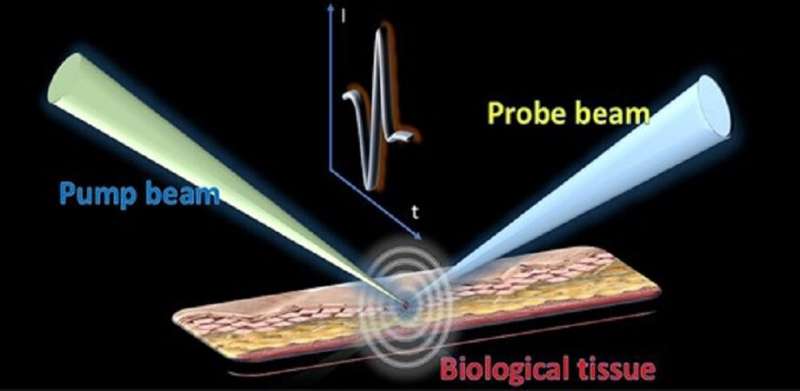This article has been reviewed according to Science X's editorial process and policies. Editors have highlighted the following attributes while ensuring the content's credibility:
fact-checked
trusted source
proofread
Photoacoustic remote sensing microscopy for lipid imaging

Photoacoustic imaging is a cutting-edge technology that uses light and sound to create images of the inside of the body. When a pulsed laser illuminates the surface of biological tissue, part of the photon energy is absorbed by the tissue to generate heat. The increase of the heat causes thermoelastic expansion of the tissue, releasing energy in the form of ultrasonic waves. By scanning the sample and collecting the corresponding photoacoustic signals, researchers are able reconstruct 2D or 3D images of the biological tissue.
Usually, ultrasonic transducers collect the photoacoustic signals. But because sound waves attenuate in air, it is usually necessary to add water or ultrasonic gel between the tissue sample and the transducer, to ensure signal detection sensitivity. Such physical contact or immersion may have significant effects on biological samples, greatly limiting the applicability of conventional photoacoustic imaging in many practical scenarios.
On the other hand, due to the innate structural and material properties of ultrasonic transducers, their central response frequency and detection bandwidth are limited, which may reduce the sensitivity of the system in terms of broadband signal detection. Considering these limitations, traditional photoacoustic imaging requires an update for high-quality photoacoustic research.
Photoacoustic remote sensing imaging is a novel photoacoustic imaging modality. Unlike conventional acoustic detection using ultrasonic transducers, photoacoustic remote sensing uses another laser beam to detect acoustic signals. Specifically, another laser source is adopted as the probe beam confocal with the excitation beam. When the sample absorbs energy to produce initial pressure, the refractive index of the sample surface changes instantaneously due to the elasto-optical refractive index modulation.
By monitoring the reflection intensity of the probe beam, the corresponding photoacoustic signals may be analyzed. All-optical detection of acoustic signals eliminates direct contact with the sample. Meanwhile, due to the optical sensing, the detection bandwidth may be easily transferred from the limited ultrasonic transducer to a broader photodiode, which provides the possibility to further improve the detection sensitivity and signal-to-noise ratio of the system.
Based on the above insights, a research team from the University of Hong Kong recently reported near-infrared photoacoustic remote sensing microscopy for non-contact imaging of lipids. As described in Advanced Photonics Nexus, the team's photoacoustic remote sensing microscopy uses a 1.7-μm thulium-doped fiber laser as the pump beam to selectively stimulate the C–H bond in lipids. At the same time, another 1.5-μm continuous-wave (CW) laser is adopted as the detection beam confocal with the pump beam to detect the initial ultrasonic pressure. This optical detection of ultrasonic signals eliminates the use of ultrasonic transducers and realizes remote sensing of photoacoustic signals. Meanwhile, this method provides a broader detection bandwidth and improves the detection sensitivity and signal-to-noise ratio of the system.
In their experiment, the team first demonstrated the imaging results of two forms of pure lipid samples through photoacoustic remote sensing and analyzed the corresponding power spectrum density of the signals. They found that the optical detection method could provide a broader frequency response compared with a conventional transducer. They also performed photoacoustic remote sensing imaging on biological samples, including nematodes and brain slices, which showed good contrast and signal-to-noise ratios, demonstrating high-performance imaging capability on the tissue scale.
"Photoacoustic remote sensing microscopy achieves label-free imaging that can target specific molecular bonds," remarks corresponding author Kenneth K. Y. Wong, Professor of Engineering at the University of Hong Kong. He adds, "Optical detection of ultrasonic signals provides non-contact operation and a broader frequency response. Meanwhile, the photoacoustic remote sensing microscopy shows high performance for lipid distribution mapping on the tissue scale."
The newly developed technique suggests great application potential in a variety of biomedical research.
More information: Guyue Hu et al, Noncontact photoacoustic lipid imaging by remote sensing on first overtone of the C-H bond, Advanced Photonics Nexus (2023). DOI: 10.1117/1.APN.2.2.026011
Provided by SPIE





















